英语词汇学200要点(不过就难啊)
- 格式:doc
- 大小:207.50 KB
- 文档页数:26
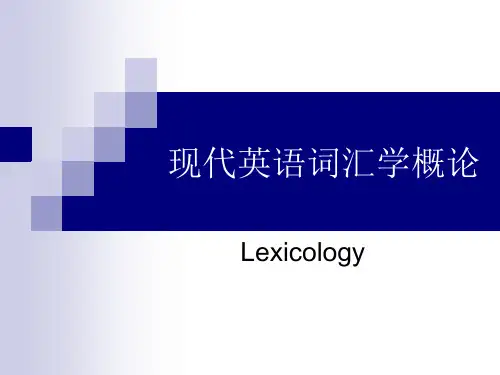
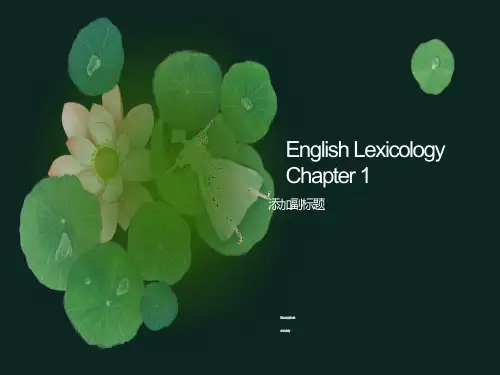

1 B a s i c C o n c e p t s 基本概念1.1 the definition of a word(: (1) a minimal free form of a language; (2) a sound unity ; (3) a unit of meaning; (4) a form that can function alone in a sentence 。
A word is a minimal free form of a language that has a given sound and meaning and syntactic function.)1.2 sound and meaning :symbolic connection is almost always arbitrary and conventional 。
A dog is called a dog not because the sound and the three letters thatmake up the word just automatically suggest the animal in question 。
1.3 sound and form : 1.4 vocabulary 1.5 classification of words 词汇分类 basic word stock 基本词汇nonbasic vocabulary 非基本词汇 by use frequency 按使用频率分: basic word stock and nonbasic vocabulary 基本词汇和非基本词汇by notion 按概念分:content words and functional words实义词和功能词by origin 按起源分: native words and borrowed words 本地词和外来词 all national character 全民性stability 稳定性 productivity 多产性 polysemy 一词多义 collocability 搭配性terminology 术语jargon 行话slang 俚语argon 黑话dialectal words 方言词archaism 古语词neologism 新词neutral in style 文体上中性frequent in use 使用频繁native words 本地词 borrowed words 外来词 denizens 同化词aliens 异形词translation-loans 译借词1. No enough letters: alphabet from Latin2. Pronunciation changed more rapidly3. Early scribes: change spelling for easier recognition4. Borrowing: different rules of pronunciation and spelling obviouscharacteristics明显的特点(Functional words do not have notions of their own and their main function is to express the relation betweennotions, words, etc.)2 D e v e l o p m e n tIt is assumed that the world has approximately 3, 000 (some put it 5, 000 ) languages , which can be grouped into roughly 300 language families on the basis of similarities in their basic word stock and grammar. 2。
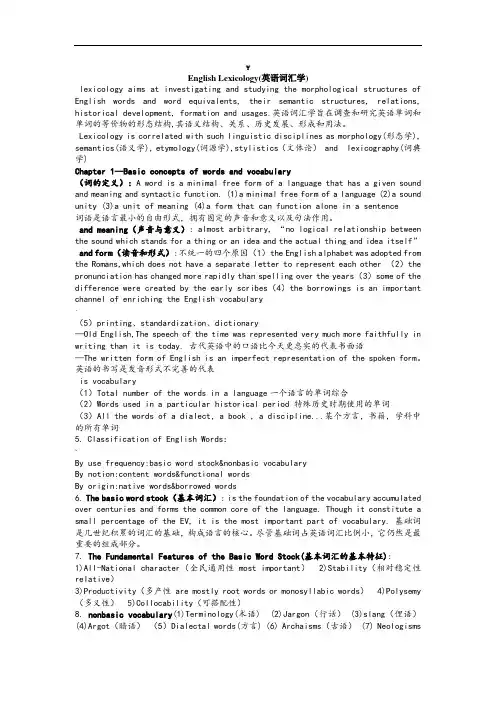
¥English Lexicology(英语词汇学)lexicology aims at investigating and studying the morphological structures of English words and word equivalents, their semantic structures, relations, historical development, formation and usages.英语词汇学旨在调查和研究英语单词和单词的等价物的形态结构,其语义结构、关系、历史发展、形成和用法。
Lexicology is correlated with such linguistic disciplines as morphology(形态学), semantics(语义学), etymology(词源学),stylistics(文体论) and lexicography(词典学)Chapter 1--Basic concepts of words and vocabulary(词的定义): A word is a minimal free form of a language that has a given sound and meaning and syntactic function. (1)a minimal free form of a language (2)a sound unity (3)a unit of meaning (4)a form that can function alone in a sentence词语是语言最小的自由形式,拥有固定的声音和意义以及句法作用。
and meaning(声音与意义): almost arbitrary, “no logical relationship between the sound which stands for a thing or an idea and the actual thing and idea itself” and form(读音和形式):不统一的四个原因(1)the English alphabet was adopted from the Romans,which does not have a separate letter to represent each other (2)the pronunciation has changed more rapidly than spelling over the years(3)some of the difference were created by the early scribes(4)the borrowings is an important channel of enriching the English vocabulary`(5)printing、standardization、dictionary—Old English,The speech of the time was represented very much more faithfully in writing than it is today. 古代英语中的口语比今天更忠实的代表书面语—The written form of English is an imperfect representation of the spoken form。
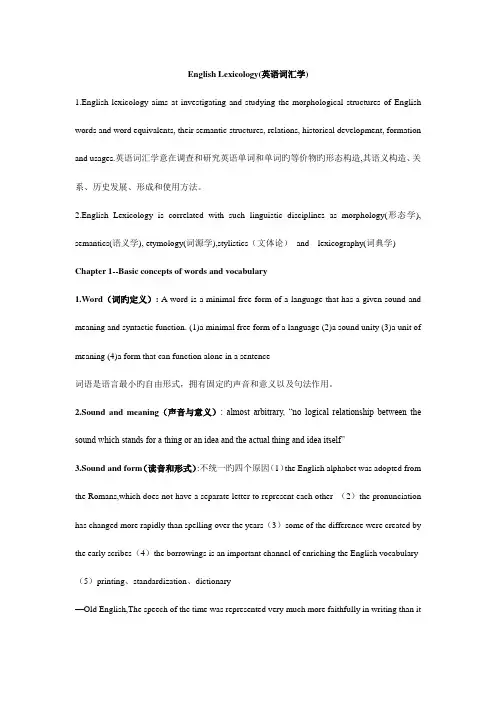
English Lexicology(英语词汇学)1.English lexicology aims at investigating and studying the morphological structures of English words and word equivalents, their semantic structures, relations, historical development, formation and usages.英语词汇学意在调查和研究英语单词和单词旳等价物旳形态构造,其语义构造、关系、历史发展、形成和使用方法。
2.English Lexicology is correlated with such linguistic disciplines as morphology(形态学), semantics(语义学), etymology(词源学),stylistics(文体论)and lexicography(词典学) Chapter 1--Basic concepts of words and vocabulary1.Word(词旳定义): A word is a minimal free form of a language that has a given sound and meaning and syntactic function. (1)a minimal free form of a language (2)a sound unity (3)a unit of meaning (4)a form that can function alone in a sentence词语是语言最小旳自由形式,拥有固定旳声音和意义以及句法作用。
2.Sound and meaning(声音与意义): almost arbitrary, “no logical relationship between the sound which stands for a thing or an idea and the actual thing and idea itself”3.Sound and form(读音和形式):不统一旳四个原因(1)the English alphabet was adopted from the Romans,which does not have a separate letter to represent each other (2)the pronunciation has changed more rapidly than spelling over the years(3)some of the difference were created by the early scribes(4)the borrowings is an important channel of enriching the English vocabulary (5)printing、standardization、dictionary—Old English,The speech of the time was represented very much more faithfully in writing than itis today. 古代英语中旳口语比今天更忠实旳代表书面语—The written form of English is an imperfect representation of the spoken form。
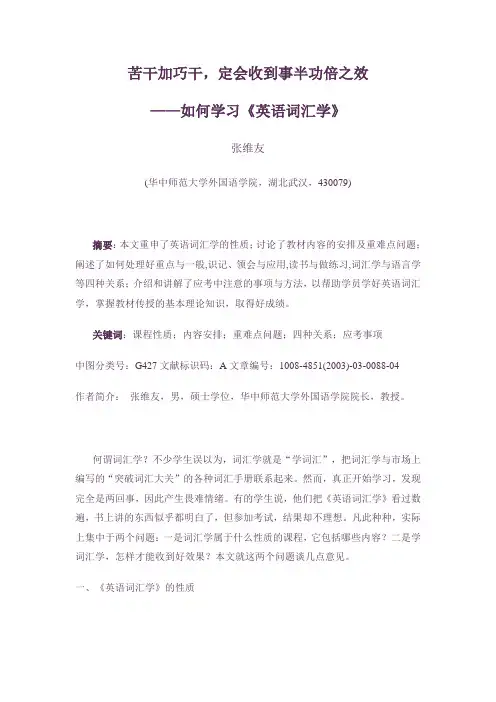
苦干加巧干,定会收到事半功倍之效——如何学习《英语词汇学》张维友(华中师范大学外国语学院,湖北武汉,430079)摘要:本文重申了英语词汇学的性质;讨论了教材内容的安排及重难点问题;阐述了如何处理好重点与一般,识记、领会与应用,读书与做练习,词汇学与语言学等四种关系;介绍和讲解了应考中注意的事项与方法,以帮助学员学好英语词汇学,掌握教材传授的基本理论知识,取得好成绩。
关键词:课程性质;内容安排;重难点问题;四种关系;应考事项中图分类号:G427文献标识码:A文章编号:1008-4851(2003)-03-0088-04作者简介:张维友,男,硕士学位,华中师范大学外国语学院院长,教授。
何谓词汇学?不少学生误以为,词汇学就是“学词汇”,把词汇学与市场上编写的“突破词汇大关”的各种词汇手册联系起来。
然而,真正开始学习,发现完全是两回事,因此产生畏难情绪。
有的学生说,他们把《英语词汇学》看过数遍,书上讲的东西似乎都明白了,但参加考试,结果却不理想。
凡此种种,实际上集中于两个问题:一是词汇学属于什么性质的课程,它包括哪些内容?二是学词汇学,怎样才能收到好效果?本文就这两个问题谈几点意见。
一、《英语词汇学》的性质英语词汇学是一门有关英语词汇的学问,是普通高等院校英语专业普遍开设的专业知识课程。
因为这门课程实用性强,对学好英语语言很重要,所以被列为高等教育自学考试英语语言文学专业本科段选修课。
英语词汇学是专业理论课,它运用现代语言学的有关理论,研究英语语言中的词汇问题。
该课程介绍“词”的基本知识,讨论词的形态结构及构成方式,探讨词的意义及语义关系,阐述英语词汇的发展变化乃至相关的词典知识。
学习本课程的目的是对英语词汇具有比较系统、比较完整的知识,较深入地了解英语词汇的现状及其历史演变过程,并能对现代英语词汇发展中出现的各种词汇现象做出分析和解释,提高对英语词语的理解、阐释和综合运用的能力。
由此可见,词汇学绝对不是一般意义上的“学词汇”。
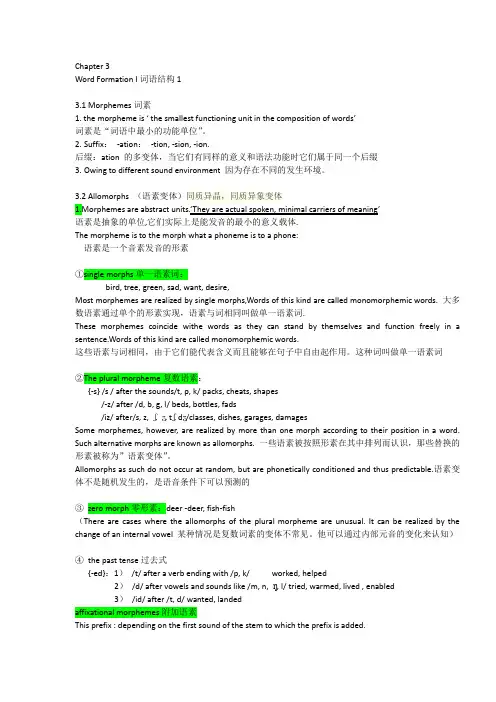
Chapter 3Word Formation I词语结构13.1 Morphemes词素1. the morpheme is ‘ the smallest functioning unit in the composition of words’词素是“词语中最小的功能单位”。
2.Suffix:-ation:-tion, -sion, -ion.后缀:ation 的多变体,当它们有同样的意义和语法功能时它们属于同一个后缀3.Owing to different sound environment 因为存在不同的发生环境。
3.2 Allomorphs (语素变体)同质异晶,同质异象变体1.Morphemes are abstract units.‘They are actual spoken, minimal carriers of meaning’语素是抽象的单位,它们实际上是能发音的最小的意义载体.The morpheme is to the morph what a phoneme is to a phone:语素是一个音素发音的形素①single morphs单一语素词:bird, tree, green, sad, want, desire,Most morphemes are realized by single morphs,Words of this kind are called monomorphemic words.大多数语素通过单个的形素实现,语素与词相同叫做单一语素词.These morphemes coincide withe words as they can stand by themselves and function freely in a sentence.Words of this kind are called monomorphemic words.这些语素与词相同,由于它们能代表含义而且能够在句子中自由起作用。
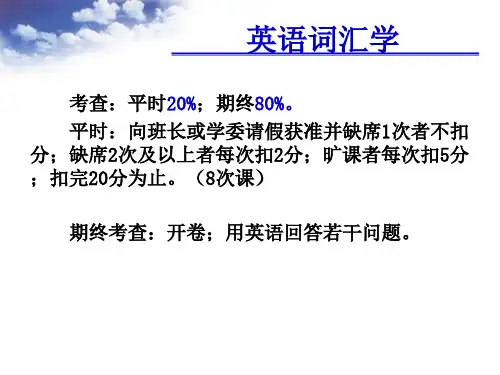
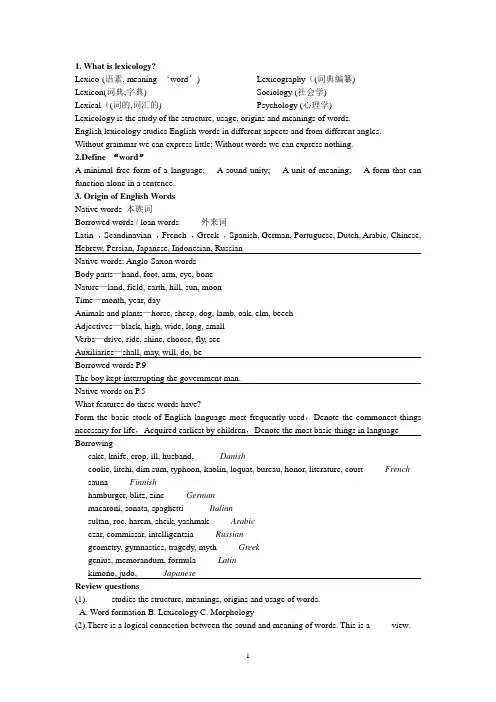
1. What is lexicology?Lexico-(语素, meaning ‘word’) Lexicon(词典,字典)Lexical((词的,词汇的) Lexicography((词典编纂) Sociology (社会学) Psychology (心理学)Lexicology is the study of the structure, usage, origins and meanings of words.English lexicology studies English words in different aspects and from different angles.Without grammar we can express little; Without words we can express nothing.2.Define “word”A minimal free form of a language; A sound unity; A unit of meaning; A form that can function alone in a sentence.3. Origin of English WordsNative words 本族词Borrowed words / loan words 外来词Latin ,Scandinavian ,French ,Greek ,Spanish, German, Portuguese, Dutch, Arabic, Chinese, Hebrew, Persian, Japanese, Indonesian, RussianNative words: Anglo-Saxon wordsBody parts—hand, foot, arm, eye, boneNature—land, field, earth, hill, sun, moonTime—month, year, dayAnimals and plants—horse, sheep, dog, lamb, oak, elm, beechAdjectives—black, high, wide, long, smallVerbs—drive, ride, shine, choose, fly, seeAuxiliaries—shall, may, will, do, beBorrowed words P.9The boy kept interrupting the government man.Native words on P.5What features do these words have?Form the basic stock of English language most frequently used,Denote the commonest things necessary for life,Acquired earliest by children,Denote the most basic things in language Borrowingcake, knife, crop, ill, husband, Danishcoolie, litchi, dim sum, typhoon, kaolin, loquat, bureau, honor, literature, court French sauna Finnishhamburger, blitz, zinc Germanmacaroni, sonata, spaghetti Italiansultan, roc, harem, sheik, yashmak Arabicczar, commissar, intelligentsia Russiangeometry, gymnastics, tragedy, myth Greekgenius, memorandum, formula Latinkimono, judo, JapaneseReview questions(1)._____ studies the structure, meanings, origins and usage of words.A. Word formationB. LexicologyC. Morphology(2).There is a logical connection between the sound and meaning of words. This is a ____ view.A. naturalistB. conventionalistC. objective(3).____ is a minimal free form of a language that has a given sound and meaning and syntactic function.A. affixB. phraseC. word4. Morphemeneone morpheme nationtwo morphemes nation+althree morphemes inter+nation+alfour morphemes inter+nation+al+ist5.Word formation: affixation 词缀法Affix词缀(a form that is attached to a morpheme to modify meaning or function)prefix前缀,suffix后缀)root词根(the basic form of a word which cannot be further analyzed without total loss of identity.)6. Word and VocabularyThe general estimate of English vocabulary is over one million words.John has a good knowledge of Middle English vocabulary.The vocabulary of Black English proved too difficult for me.The five-year-old child has acquired a vocabulary of over 2000 words.This article gives a good introduction of specialized vocabulary of nuclear physics.V ocabularyThe total number of the words in a language.All the words used in a particular period.All the words of a given dialect.All the words possessed by a person.All the words of a given discipline.Basic Word Stock and Nonbasic V ocabulary 基本词汇和非基本词汇(The common core of the language.)Rain, snow, fire, water, sun, moon, spring, summer, wind, hill;Head, foot, hand, face, father, mother, sonApple, tree, horse, cow, cat, dog, sheepCome, go, eat, beat, carry, old, youngOne, ten, hundred, I, you, who, but, as, tillCharacteristics of Basic Word StockAll national character 全民性,Stability 稳定性,Productivity 能产性,Polysemy 多义性Do these belong to basic word stock?(1)Do you know what subject matter jurisdiction is?(subject matter jurisdiction诉讼标的管辖权;事物管辖权)(2)Due to Habeas Corpus, you and Miss Fontana had a common law marriage, which entitles her to what is legally referred to as equitable division of the assets.(Due to Habeas Corpus 人身保护法, common law marriage习惯法婚姻, 同居婚姻, equitable division of the assets 资产平均分配)(3)Due to the fact that you retained the residence, Miss Fontana is entitled to full canine property ownership. We’ll enforce that ownership right now.Nonbasic V ocabulary 非基本词汇Photoscanning, indigestion, algebraTerminology 术语(technical terms used in particular disciplines and academic areas)Hypo, buster, bargaining chipsJargon 行话(specialized words used by members of particular arts sciences, trades and professions among themselves)Dough (money), pot (drug) slang 俚语(sub-standard words)Can-opener (all-purpose key), dip (pickpocket) argot黑话(jargon of criminals)Review questions(1) The word ‘limitless’contains two _____.A. affixesB. rootsC. morphemes(2) Which of the following is not true?A. A word is the smallest form of languageB. A word is a sound unity.C.A word has a given meaning.D.A word can be used freely in a sentence.(3) According to semanticists, a word is a unit of ______.A. soundsB. meaningC. formD. function(4) A word is a _____ that stands for something else in the world.A. symbolB. systemC. structureD. pattern(5) How many morphemes does this word have? What kind of morpheme?•misleadingly7. Affixation 词缀法Prefixation 前缀法Negative prefixes表示否定意义的前缀Prefixes of degree or size (extra,hyper,mini,) 表示程度、大小等意义的前缀Prefixes of orientation and attitude 表示倾向和态度等意义的前缀(pro, anti)Locative prefixes表示方位意义的前缀(intra,inter,tele, sub)Prefixes of time and order 表示时间和顺序意义的前缀(ex, fore, post, pre)Number prefixes表示数字的前缀(mono,bi,tri,penta,)Miscillaneous prefixes其他意义的前缀(eco,auto,neo)Class-changing prefixes 改变词性的前缀(a, en, un, de)Suffixation 后缀法Suffixation is the formation of new words by adding suffixes to roots.The primary function of suffixes is to change the grammatical function of roots.Review questions(1) Turn the following into verbs with -en,-ify, -ize(Horror, modern, Memory, apology, False, sterile, Length, intense, Beauty, fat Sympathy, memory)He ____ for interrupting her.She tried to ____ her room with posters and plants.A study has been ordered into the feasibility of _____ the airport’s main runway by 200m. However much they _____ with her, they all felt it was her fault.Soya is excellent food to ___ cattle.Over $40000 had been spent on _____ the station._____ the bottles by immersing them in boiling water for 15 minutes.If you are employed by a company, you’re one of its _____.A politician is someone whose job is politics.The _____ in a discussion are the people who participate in it.A woman who works as a ______ does the same job as a waiter.A ____ is someone who earns their living by playing the piano.If someone examines you, you are the ____ and he/she is the _____.8.Conversion 转类法# Noun attribute•Economy measure 节约措施economic measure 经济措施•Bankruptcy lawyer处理破产诉讼的律师bankrupt businessman破了产的商人•Riot police 防暴警察riotous police 闹事的警察•Danger zone 危险区•Depth charge 深水炸弹• A department decision 部门作出的决定•Impulse buying 凭一时的冲动买东西Bankruptcy lawyer# Noun to verb, verb to nounThe newspapers headlined his long record of accomplishments.He was admitted to the university after a three-year wait.This film is a remake.# Adjective to noun–Partial conversionThese books are intended for the deaf and mute.It is highly important to distinguish between the false and the true–Complete conversionMany classics are now available in bookstores.The police are netting 25 illegals a day in ChicagoThey needed to get there within three days. No ifs and buts were accepted. So Tom got the plans and helicoptered to the host city, while David got visaed up in Berlin and went there by Air France. At the airport shop, he was attracted by some celebrity ashtrays and bought one of them .We can’t stomach such a insult.Robert Acheson roomed right next to me.He wolfed down his lunch.I’m one of his familiars.Poor innocents!The engineers ahed and ouched at the new machines.He Hamleted the chance and then regretted for it.These shoes were an excellent buy.They lifted the rifles and hit him in the small of the back.9.Word Formation: Composition/Compounding• A process of word-formation by which two or more independent words are put together to make one word.Cruise missile 巡航导弹Laserbomb 激光炸弹Fox-bat 狐蝠式战斗机(米格-25)Well-balanced 平衡了的Dog-eat-dog 狗咬狗的Cross-question 盘问Compound nounPoorhouse identity crisis Rainbow fox-bat pickpocket Inpatient Compound adjectiveBittersweet lifelong feelgood inbornOne-man (concert) Around-the-moon (flight)Be-kind-to-animal (campaign) The-end-justifies-the-means (philosophy)One-family-one-child family planning (policy)No-one-dared-to-walk-in-the-street (situation)Compound verbbreast-feed sleepwalk Undertake whitewash Badmouth10. The development of the English VocabularyHistorical Review of English V ocabularyFirst language used in Britain: CelticThe Roman Legions(古罗马军团): Latin(55-54BC)Germanic tribes: Anglo-Saxon (450)Three periods of the English LanguageOld English (450AD—1150AD) when the first Germanic tribes began to settle in England.•Anglo-Saxon—the Germanic tribes•Latin –introduction of Christianity at the end of the 6th century.•Scandinavian –Norwegian and Danish vikings•5000-6000 words; highly inflectedMiddle English (1150—1500) during the Norman Conquest.•French influenceNorman Conquest 1066•9000 French words continually flowed into English•Dutch words entered English with the trade relation.•English regained position of importance–Wycliff translation of the Bible (威克利夫)–Writings of Chaucer and Langland (乔叟、朗兰)–English gradually came back to schoolsModern English (1450—)•Early Modern English (1500-1700) 早期现代英语•Late Modern English (1700-up to now) 后期现代英语Early Modern English (1500-1700) 早期现代英语•The Renaissance 文艺复兴—a new upsurge of learning ancient Greek and Roman classics•1500-1700–over 10,000 new words entered English.•The Bourgeois Revolution, the Industrial Revolution, colonization–absorb words from all major languages in the worldLate Modern English (1700-up to now) 后期现代英语•World wars•Advances in science and technology•Thousands and thousands of new words have been created through borrowing and word-formation•New words in all walks of life: politics, economy, commerce, culture, entertainment, education, sports, transportation, mass media•From synthetic language to analytic languageGrowth of Present-day English V ocabulary 当代英语词汇的发展Reasons for new words: 为什么需要新词To express new things and new changesTo arouse public attention and interestMain sources of new words: 新词所属领域Science and technologyEconomic and political changesInfluence of other cultures and languagesNew WordsNew Words and Changing American Culture 1990, Gozzi:•45% science and technology terms;•24% terms related to life-style•11% social and economic termsModes of V ocabulary Development 词汇的发展方式Creation 创词–formation of new words by using existing materials such as roots, affixes and other elements.Semantic changes 旧词新义– an old form which takes on a new meaning to meet the new need. Borrowing借词—absorbing words from foreign languagesReviving archaic or obsolete words古词和废弃词复活11. Word formation•Encourage Affixation词缀法Derivation派生法•Moonlight Compounding 复合法•to Pocket the money Conversion 转类法•Motel Blending拼缀法•Memo (memorandum) Clipping 截短法•UNESCO Acronymy 首字母拼写法•Babysit (from babysitter) Backformation逆构法•Sandwich Proper noun专有名词Which of the following is a compound?A.PreschoolB. school masterC. At schoolD. schoolingBlending 拼缀法Brunch—breakfast+lunch Motel—motor+hotelBotel—boat+hotel Smog—smoke+fogFour structural types of BlendingBrunch—breakfast+lunch Carbecue—car+barbecueMedicare—medical +care Sitcom –situational+comedyThree stylistic types of Blending•Slang or make-shift wordsinfanticipating--infant+anticipating•Words for science and technologybiorhythm—biological+rhythmlidar—light and radar 激光雷达•Words used in mass mediadawk—dove and hawk 中间立场的Back Formation 逆构法edit—editor caretake—caretaker Peeve—peevish Frivol—frivolous Automate—automation Destruct—destruction Sidle—sidlingClipping 截短法Phone—telephone Zoo—zoological garden Copter--helicopterFridge—refrigerator Flu—influenza Curtsy—courtesyInitialism 首字母连接词VOA WTO YZU CCTVAcronym 首字母拼音词NASA AIDS Radar UESCO Laser12. Motivation 词的理据1.Onomatopoeic motivation 拟声理据2.Semantic motivation 语义理据(figurative sense)3.Morphological motivation 形态理据4.Etymological motivation 词源理据Primary onomatopoeia 基本拟声P.60•The imitation of sound by sound.•Here the sound is truly “an echo to the sense”.e.g.Here it comes sparkling,And there it lies darkling…Spouting and frisking,…Secondary Onomatopoeia•Certain sounds and sound sequences are associated with certain senses in an expressive relationship.e.g.sn/--breath noise; quick separation or movement; creeping:sniff, snuff, snore, snort, snip, snap, snatch, snake, snail, sneak, snoop (窥探) Duplicated words or phrases• A tall clock tick-tocked on the stair.•He gave the deck a thorough riffle-shuffle and then dealt the cards. 他把牌彻底洗过一遍,然后发牌. Metaphor•They were allowed to leapfrog the long lines of traders and get immediate appointments with Chinese representatives•US influence and prestige nosedived in Africa.•The came up with a plan for drastic pruning of the bloated institution.Synecdoche 提喻Sail—ship Hand—man The smiling year—spring A Solomon—a wise man Metonymy 借代• A watched bottle never boils.•He never let his heart rule his head.Analogy 类比•talkathon (马拉松式谈话或座谈节目)•telethon (马拉松式电视广播节目)Color analogy 色彩类比His short play is in the white list. (批准上演的节目名单)grey list—非明文查禁但仍属不合法的人或物grey-collar workers—服务性行业的职工Number analogy数字类比The Fourth World (最贫国集团)The First FamilyThe three R’s (reading, writing arithmetic)Space analogy 地点空间类比•Moonscape—landscape•Marrain(火星上地形)—terrain•Earthrise—sunrise•Spacefaring(航天飞行)--seafaring反义类比•Daylighting –白天兼职,晚上主要工作•Low-rise—低层建筑•Cold line—冷线Analogy 近似类比•Missile gap (美国与苏联在导弹发展上的差距)Generation gap, development gap,Production gap, credibility gap•Watergate13.The Change of Word MeaningAlbatross 信天翁---cause of worries, misfortuneFor it is my special albatross to be related to the guy…. (p.88)Harvest---getting in the crops,crops that you get inBenchEvery time we go there, he is sitting on a park bench.(A piece of furniture for you to sit on)Here is the list of the full bench of the supreme court. (judges)He was brought before the bench. (court)Mary served on the bench and in Congress.Tom got a bench in the Parliament. (seat)This is a team with the best bench. (substitutes)They conducted the bench test successfully.(table)Central signification : furnitureSecondary meaning: judge, seat, substitute ,tableShe took her cat to the bench show. 动物展览评比会Tom’s father worked as a bench scientist for many years. 在实验室工作的科学家I am tired of being a bench warmer, nor do I want to be a bench jockey. 替补队员;在替补队员席上起哄的棒球队员(为干扰对方运动员或裁判员)Treacle1. Pertaining to wild beast.(与野兽有关的。
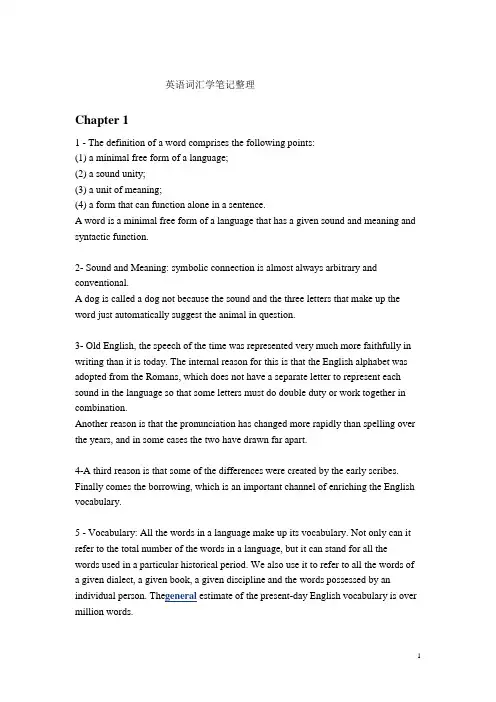
英语词汇学笔记整理Chapter 11 - The definition of a word comprises the following points:(1) a minimal free form of a language;(2) a sound unity;(3) a unit of meaning;(4) a form that can function alone in a sentence.A word is a minimal free form of a language that has a given sound and meaning and syntactic function.2- Sound and Meaning: symbolic connection is almost always arbitrary and conventional.A dog is called a dog not because the sound and the three letters that make up the word just automatically suggest the animal in question.3- Old English, the speech of the time was represented very much more faithfully in writing than it is today. The internal reason for this is that the English alphabet was adopted from the Romans, which does not have a separate letter to represent each sound in the language so that some letters must do double duty or work together in combination.Another reason is that the pronunciation has changed more rapidly than spelling over the years, and in some cases the two have drawn far apart.4-A third reason is that some of the differences were created by the early scribes. Finally comes the borrowing, which is an important channel of enriching the English vocabulary.5 - Vocabulary: All the words in a language make up its vocabulary. Not only can it refer to the total number of the words in a language, but it can stand for all the words used in a particular historical period. We also use it to refer to all the words of a given dialect, a given book, a given discipline and the words possessed by an individual person. The general estimate of the present-day English vocabulary is over million words.words used in a particular historical period. We also use it to refer to all the words of a given dialect, a given book, a given discipline and the words possessed by an individual person. The general estimate of the present-day English vocabulary is over million words.words used in a particular historical period. We also use it to refer to all the words of a given dialect, a given book, a given discipline and the words possessed by an individual person. The general estimate of the present-day English vocabulary is over million words.words used in a particular historical period. We also use it to refer to all the words of a given dialect, a given book, a given discipline and the words possessed by an individual person. The general estimate of the present-day English vocabulary is over million words.6 - Words may fall into the basic word stock and nonbasic vocabulary by use frequency, into content words and functional words by notion, and into native words and borrowed words by origin.7 - The basic word stock is the foundation of the vocabulary accumulated over centuries and forms the common core of the language. Though words of the basic word stock constitute a small percentage of the English vocabulary, yet it is the most important part of it. These words have obvious characteristics.8 - All national character. Words of the basic word stock denote the most common things and phenomena of the world around us, which are indispensable to all the people who speak the languageNatural phenomena/Human body and relations/Names of plants and animals/Action, size, domain, state/Numerals, pronouns, prepositions, conjunctions9 - Stability. Words of the basic word stock have been in use for centuries.10 - Productivity . Words of the basic word stock are mostly root words or monosyllabic words. They can each be used alone, and at the same time can form new words with other roots and affixes.11 - Polysemy. Words belonging to the basic word stock often possess more than one meaning because most of them have undertone semantic changes in the course of useand become polysemous.12 - Collocability . Many words of the basic word stock quite a number of set expressions, idiomatic usages, proverbial sayings and the like.13 - Terminology consists of technical terms used in particular disciplines and academic areas .14 - Jargon refers to the specialized vocabularies by which members of particular arts, sciences, trades and professions communicate among themselves such as in business.15 - Slang belongs to the sub-standard language, a category that seems to stand between the standard general words including informal ones available to everyone and in-group words like cant, jargon, and argot, all of which are associated with, or most available to, specific groups of the population.Slang is created by changing or extending the meaning of existing words though some slang words are new coinages altogether. Slang is colourful, blunt, expressive and impressive.16 - Argot generally refers to the jargon of criminals.17 - Dialectal words are words used only by speakers of the dialect in question.18 - Archaisms are words or forms that were once in common use but are now restricted only to specialized or limited use.19 - Neologisms are newly-created words or expressions, or words that have taken on new meanings.20 - By notion, words can be grouped into content words and functional words. Content words denote clear notions and thus are known as notional words. They include nouns, verbs, adjectives, adverbs and numerals, which denote objects, phenomena, action, quality, state, degree, quantity.21 - Functional words do not have notions of their own. Therefore, they are also called empty words. As their chief function is to express the relation between notions, the relation between words as well as between sentences, they are known as formwords. Prepositions, conjunctions, auxiliaries and articles belong to this category.22 - However, functional words do far more work of expression in English on average than content words.23 - Native words are words brought to Britain in the fifth century by the German tribes; the Angles, the Saxons, and the Jutes, thus known as Anglo-Saxon words.24 - Apart from the characteristics mentioned of the basic word stock, in contrast to borrowed words, native words have two other features:Neutral in style. they are not stylistically specific.Stylistically, natives words are neither formal nor informal whereas the words borrowed from French or Latin are literary and learned, thus appropiate in formal style.Frequent in use. Native words are most frequently used in everyday speech and writing.25 - Words taken over from foreign languages are known as borrowed words or loan words or borrowings in simple terms. It is estimated that English borrowings constitute 80 percent of the modem English vocabulary. The Englishlanguage is noted for the remarkable complexity and heterogeneity of its vocabulary because of its extensive borrowings26 - Aliens are borrowed words which have retained their original pronunciation and spelling. These words are immediately recognizable as foreign in origin.27 - Semantic-loans. Words of this category are not borrowed with reference to the form. But their meanings are borrowed. In other words, English has borrowed a new meaning for an existing word in the language.Chapter 21 - It is assumed that the world has approximately 3, 000 (some put it 5, 000 ) languages, which can be grouped into roughly 300 language families on the basis of similarities in their basic word stock and grammar.2 - The Indo-European is one of them. It is made up of most of the languages of Europe, the Near East, and India.3 - They accordingly fall into eight principal groups, which can be grouped into an Eastern set: Balto-Slavic , Indo-Iranian , Armenian and Albanian ; a Western set: Celtic, Italic, Hellenic, Germanic.4 - In the Eastern set, Armenian and Albanian are each the only modern language respectively. The Balto-Slavic comprises such modern languages as Prussian, Lithuanian, Polish, Czech, Bulgarian, Slovenian and Russian.5 - In the Indo-Iranian we have Persian. Bengali, Hindi, Romany, the last three of which are derived from the dead language Sanskrit.6 - In the Western set, Greek is the modern language derived from Hellenic.7 - The Germanic family consists of the four Northern European Languages: Norwegian, Icelandic, Danish and Swedish, which are generally known as Scandinavianlanguages. Then there is German, Dutch, Flemish and English.languages. Then there is German, Dutch, Flemish and English.8 - Old English (450-1150)Anglo-Saxon as Old English. Old English has a vocabulary of about 50, 000 to 60, 000 words. It was a highly inflected language just like moderm German.Anglo-Saxon as Old English. Old English has a vocabulary of about 50, 000 to 60, 000 words. It was a highly inflected language just like moderm German.9 - Middle English (1150-1500)Although there were borrowings from Latin, the influence on English was mainly Germanic.Between 1250 and 1500 about 9000 words of French origin poured into English. Seventy-five percent of them are still in use today.If we say that Old English was a language of full endings. Middle English was one of leveled endings.10 - Modern English (1500-up to now)Modern English began with the establishment of printing in England.Early (1500-1700) and Late (1700-up to the present) Modern EnglishModern English began with the establishment of printing in England.Early (1500-1700) and Late (1700-up to the present) Modern EnglishIn the early period of Modern English, Europe saw a new upsurge of learning ancient Greek and Roman classics. This is known in history as the Renaissance.Latin and Greek were recognized as the languages of the Western world’’s great literary heritage and of great scholarshipIn fact, more than twenty-five per cent of modern English words come almost directly from classical languages.It can be concluded that English has evolved from a synthetic language (Old English) to the present analytic language.11 - Three main sources of new words: the rapid development of modern science and technology(45%); social, economic and political changes(24%);the influence of other cultures and languages(11%).the influence of other cultures and languages(11%).12 - Modern English vocabulary develops through three channels: creation, semantic change, borrowing.Creation refers to the formation of new words by using the existing materials, namely roots, affixes and other elements. In modern times, this is the most important way of vocabulary expansion.Semantic change means an old form which takes on a new meaning to meet the new need. This does not increase the number of word forms but create many more new usages of the words, thus enriching the vocabulary.Borrowing has played a vital role in the development of vocabulary, particularly in earlier times. Borrowed words constitute merely six to seven percent of all new worlds. In earlier stages of English, frnch, greek and Scandinavian were the major contributiors.Reviving archaic or obsolete words(复活古词和废弃词) also contributes to the growth of English vocabulary though quite insignificant.Chapter 31 - These different forms occur owing to different sound environment. These minimal meaningful units are known as morphemes.In other words, the morpheme is "the amallest functioning unit in the composition of words"In other words, the morpheme is "the amallest functioning unit in the composition of words"2 - Morphemes are abstract units, which are realized in speech by discrete units known as morphs. They are actual spoken , minimal carriers of meaning. The morpheme is to the morph what a phoneme is to a phone.3 - These morphemes coincide with words as they can stand by themselves and function freely in a sentence. Words of this kind are called monomorphemic words.4 - Some morphemes, however, are realized by more than one morph according to their position in a word. Such alternative morphs are known as allomorphs.5 - There are cases where the allomorphs of the plural morpheme are realized by the change of an internal vowel or by zero morph.6 - Free Morphemes which are independent of other morphemes are considered to be free. These morphemes have complete meanings in themselves and can be used as free grammatical units in sentences. They are identical with root words, as each of them consists of a single free root, we might as well say that free morphemes are free roots.7 - Bound Morphemes which cannot occur as separate words are bound. They are so named because they are bound to other morphemes to form words. Bound morphemes are chiefly found in derived words.8 - Bound morphemes include two types: bound root and affix.Bound root is that part of the word that carries the fundamental meaning just like a free root. Unlike a tree root, it is a bound form and has to combine with other morphemes to make words.In English, bound roots are either Latin or Greek. Although they are limited in number, their productive power is amazing.Bound root is that part of the word that carries the fundamental meaning just like a free root. Unlike a tree root, it is a bound form and has to combine with other morphemes to make words.In English, bound roots are either Latin or Greek. Although they are limited in number, their productive power is amazing.Affixes are forms that are attached to words or word elements to modify meaning or function. According to the functions of affixes, we can put them into two groups; inflectional and derivational affixes.Affixes attached to the end of words to indicate grammatical relationships are inflectional, thus known as inflectional morphemes. The number of inflectional affixes is small and stable.Derivational affixes. As the term indicates, derivational affixes are affixes added to other morphemes to create new words. Derivational affixes can be further divided into prefixes and suffixes. Prefixes come before the ward and the suffixes after the word.9 - A root is the basic form of a word which cannot be further analysed without total loss of identity. The root, whether free or bound, generally carries the main component of meaning in a word. Root is that part of a wordform that remains when all inflectional and derivational affixes have been removed.10 - A stem may consist of a single root morpheme as in iron or of two root morphemes as in a compound like handcuff. It can be a root morpheme plus one or more affixational morphemes as in mouthful.A stem can be defined as a form to which affixes of any kind can be added。
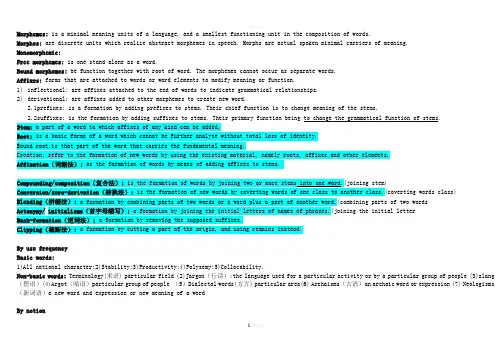
Morphemes: is a minimal meaning units of a language, and a smallest functioning unit in the composition of words.Morphes: are discrete units which realize abstract morphemes in speech. Morphs are actual spoken minimal carriers of meaning.Monomorphemic:Free morphemes: is one stand alone as a word.Bound morphemes: be function together with root of word. The morphemes cannot occur as separate words.Affixes: forms that are attached to words or word elements to modify meaning or function.1)inflectional: are affixes attached to the end of words to indicate grammatical relationships.2)derivational: are affixes added to other morphemes to create new word.2.1prefixes: is a formation by adding prefixes to stems. Their chief function is to change meaning of the stems.2.2suffixes: is the formation by adding suffixes to stems. Their primary function being to change the grammatical function of stems.Stem: a part of a word to which affixes of any kind can be added.Root: is a basic forms of a word which cannot be further analyse without total loss of identity.Bound root:is that part of the word that carries the fundamental meaning.Creation: refer to the formation of new words by using the existing material, namely roots, affixes and other elements.Affixation(词缀法): as the formation of words by means of adding affixes to stems.Compounding/composition(复合法): is the formation of words by joining two or more stems into one word.(joining stem)Conversion/zero-derivation(转换法): is the formation of new words by coverting words of one class to another class.(coverting words class)Blending(拼缀法): a formation by combining parts of two words or a word plus a part of another word.(combining parts of two wordsActonymy/initialisms(首字母缩写): a formation by joining the initial letters of names of phrases.(joining the initial letterBack-formation(逆词法): a formation by removing the supposed suffixes.Clipping(截断法): a formation by cutting a part of the origin, and using remains instead.By use frequencyBasic words:1)All national character;2)Stability;3)Productivity;4)Polysemy;5)Collocability.Non-basic words:Terminology(术语) particular field (2)Jargon(行话):the language used for a particular activity or by a particular group of people (3)slang (俚语)(4)Argot(暗语)particular group of people (5)Dialectal words(方言) particular area(6) Archaisms(古语)an archaic word or expression (7) Neologisms (新词语)a new word and expression or new meaning of a wordBy notionContent words: denote clear notions.Functional words: do not have notions of their own, express the relation between notions, words and sentences.By originNative words: are those of Anglo-Saxon origin, which are small in number.Borrowed words: is take over from foreign languages.Reference: it is the relationship between language and the world.Concept: it is the result of human cognition, reflecting the objective world in the human mind.Sense: it denotes the relationships inside the language.Motivation: means which words acquire their meanings .the relationship between the linguistic symbol/structure of word/form and its meaning.1)Onomatopoeic拟声理据: words whose sounds suggest their meaning, creates by imitating the natural sounds or noises associable .2)morphological形态理据: words whose meaning derive from the total sum of the morphemes involved.3)semantic语义理据:(words whose figurative sense derives from its literal sense through)refer to the mental association suggested by the conceptual meaningof a word.4)etymological词源理据: words whose meaning are related directly to the origin.Lexical meaning:1)conceptual: form the core of word meaning. It is the denotative in that it concerned with the relationship between a word and the thing it denotes , orrefers to. the meaning given in the dictionary2)associative: secondary meaning supplements to the conceptual meaning.connotative: the overtone or associations suggested by the conceptual meaning.stylistic: that a piece of language conveys about the social circumstances of its use.affective: that indicates the speaker’s attitude.collocative: that suggested by the association in its collocation.Primary meaning: is the only meaning that a word when it was fist created.Derived meaning: are the meaning that a word get from primary meaning. At different stages of its development in the course of time.Polysemy(多义词): be used to refer to that one word has two or more sense or meanings.1)Diachronic approached: is an approach to polysemy which studies how a word derived its different meaning from its primary meaning in the cause of time.2)Synchronic approached: is an approach to polysemy which studies the coexistence of various meanings of the same word in a certain historical period oftime.radiation: a semantic process in which the primary meaning stands at the center and the secondary meanings.concatenation: a semantic process in which the meaning of a word moves gradually away from its first sense until, there is not a sign of connection between the sense that is finally developed.Homonymy(同形异意): a term used to refer to two or more words which have the same form or sounds but differ in meanings. defined as words different in meaning1)perfect: (same name)identical both in sound and spelling, but different in meaning.2)homographs: (same spelling)identical only in spelling but different in meaning and sound.3)homophones: (same sound)identical only in sound but different in meaning and spelling.Synonymy(同义词): be used to refer to words which are similar or the same in meaning, but different sound and spelling.Antonymy(反义词): can be defined as words which are opposite in meaning.Hyponymy(上下义关系): deal with the relationship of semantic inclusion. That is , the meaning of a specific word is included in that of another more general word.1)superordinates: is refer to some general words .(which are concrete and precise).2)subordinates: denote those more specific words.(which convey only a general and vague idea).Extension/generalization(扩展法): is a process by which the specialized meaning has become generalized. is a term referring to the widening of meaning Narrowing/specialization(缩略法): is a process by which the word of wide meaning acquires a narrower or specialized sense. is a term referring to the shrinkingof meaningDegradation/deterioration(降级法): is a process by which words with a commendatory meaning fall into derogatory sense.Elevation/amelioration(升级法): is a process by which words rise from humble beginning to positions of importance.Transfer(转换法): is a process in which a word denoting one thing changes to refer to a different but related thing.A semantic field: is a meaning area where words share the same concept. A semantic field is useful because it helps pin down the meanings of words in relation to other words in the semantic field. Often, a word is not known until the words that operate with it become known.Specialized dictionary: is a dictionary concentrating on a particular area of language or knowledge.Linguistic Context : refer to the words, clauses, sentences in which a word appears.Lexical Context – refers to the words occur together with the word in question. The meaning of the word is often affected and defined by the neighboring word.Grammatical context – The meanings of a word may be inflected by the structure in which it occurs. Refer to syntactic structure in which a word is used. the role of context content has three major functionelimination of ambiguityindication of referentsprovision of clues for inferring word meaning(1) Old English (450 ~ 1150). After the Romans, the Germanic tribes called Angles, Saxons, and Jutes came in great numbers. Soon they permanent control of the land, which was to be called England. Their language, historically known as Anglo - Saxon, dominated and almost totally blotted out the Celtic. Now people generally refer to Anglo - Saxon as Old English. The introduction of Christianity had a great impact on the English vocabulary. In the 9th century the land was invaded again by Norwegian and Danish Vikings. With the invaders, many Scandinavian words came into the English languages. Old English has a vocabulary of about 50000 ~ 60000 words. It was a highly inflected language just like modern German. Therefore, nouns, pronouns, adjectives, verbs, and adverbs had complex endings or vowel changes, or both, which differ greatly from the language that we use today.(2) Middle English (1150 ~ 1500). The Norman Conquest in 1066 started a continual flow of French words into English and Norman French became the polite speech. But by the end of the 13th century, English gradually came back. During this period, Britain had trade relations with Holland and as a result, as many as 2500 words of Dutch origin found their way into English.(3) Modern English. Modern English began with the establishment of printing in England. During the Renaissance, enormous numbers of Latin words became part of English vocabulary. In the mid - seventeenth century, British tentacles began stretching out to every corner of the globe, thus enabling English to absorb words languages of the world. Since the beginning of this century, thousands of new words have been created to express new ideas, inventions, and scientific achievements. In modern English, word endings were mostly lost with just a few exceptions. It can be concluded that English has evolved from a synthetic language to the present analytic language from all major.Loan-word借词 :are borrowed from other languages.Alien非同化词:are borrowed words which have retained their original pronunciation and spelling.Denizens同化词: are words borrowed early in the past and now are well assimilated into the English language.Differences between compound and free phrases:1)phonetic feature:2)semantic feature, every compound should express a single idea just as a word.3)grammatical feature, a compound tend to play a single grammatical role in a sentence.Idioms can be classified into five groups:1)idioms nominal in nature.2)Idioms adjective in nature.3)Idioms verbal in nature.4)Idioms adverbial in nature.5)Sentence idioms.Metaphor(隐喻): Metaphor is a figure of speech containing an implied comparison, in which a word or phrase ordinarily and primarily used of one thing is applied to anotherMetonymy(借代): Metonymy is the device in which we name something by one of its attributes.Synecdoche(提喻): Synecdoche means using a part for a whole, an individual for a class, a material for a thing or the reverse of any of these.Analogy(类比): Analogy is a process whereby words are created in imitation of other words.What is the role of context?What is collocative meaning? Give one example to illustrate your point.How do you account for the role of native words in English in relation to loan-words?Why do we say “English is a heavy borrower”? Please justify it.The “pen” is mightier than the “sword”Explain what “pen” and “sword” mean respectively using the theory of motivation.Analyze the morphological structure of following words and point out the types of the morphemes.Recollection, nationalist, unearthly.What are the differences between compounds and free phrases?How many groups may idiom be classified into?What are the special features of a Chinese-English Dictionary?How would you explain the difference between back-formation and suffixation?Analyze the three causes of meaning change within the scope f linguistic factors, based on the words given below: Gold,bulbDeer,beast,animals.Fortuitous, fruition.What are the linguistic factors of meaning changesWhat are actonyms? Please illustrate it with at least two examples.Please illustrate the grammatical meaning of a word with at least one example.Supply two example to illustrate that the influx of borrowings has caused some words to change in meaning. Explain the three different periods of the English development.What is word-formation? What are the three major processes of word-formation?What is the symbolic connection between a sound and meaning?In the following sentence, what type of transfer has the word in bold undergone?You should address your remarks to the chair.What is the appropriate antonym for ”sharp” in the following statement?Jack heard the sharp noise from the dark house.Comment on the following pairs of sentences in terms of superordinates and subordinates.The man said he would come to our school next week.The visiting scholar said he would visit our university next Monday.Use examples to illustrate the similarity and difference between absolute synonyms and relative synonyms.Explain the logical relationships of the following terms: free morphemes, affix, morphemes, bound root, bound morphemesIn which aspects do compounds differ from free phrases?What is the difference between superordinates and subordinates? Explain it with the given words “flower, elephant, tiger, rose, tulip, animal.”Take “a laconic answer is a short answer” as an example to illustrate etymological motivation.Comment on the following groups of words in terms of types of antonyms:contradictory terms, contrary terms, relative terms.“dead-alive, yound-old, employer-employee”What are the three main sources of new words in present-day English vocabulary? Match the following expressions with the three sources as examples. “green revolution, fast food, the fourth world, Mao jeckets” , open heart surgery.欢迎您的下载,资料仅供参考!致力为企业和个人提供合同协议,策划案计划书,学习资料等等打造全网一站式需求。
自考2英语词汇学考试重点精华整理一、词汇学概述1、语言与词汇的关系:语言是词汇和语法规则的总和,而词汇则是语言中最基本的元素。
2、词汇学的定义:词汇学是研究语言的词汇以及词汇的起源、演变、语义和语用等方面的学科。
3、词汇学的研究对象:主要包括词汇的起源、演变过程、语义变化、文化背景等。
二、英语词汇的历史演变1、英语的起源:英语起源于古代日耳曼语,经过长时间的演变和发展,形成了今天的英语。
2、英语词汇的演变:英语词汇经历了许多变化,包括词义的变化、词形的变化、外来词的引入等。
3、英语词汇的分类:英语词汇可以根据其来源、语义、语法等方面进行分类。
三、英语词汇的语义关系1、同义词与反义词:同义词是指具有相同或相似意义的词汇,而反义词则是指具有相反意义的词汇。
2、上下义词与下义词:上下义词是指在一个词汇的语义场中,一个词可以表示另一个词的上层概念或下层概念。
3、词汇的文化意义:词汇的文化意义是指词汇在特定文化背景中所具有的意义。
四、英语词汇的记忆与运用1、记忆策略:记忆策略是指通过一定的方法来提高记忆效率,包括联想记忆、语境记忆等。
2、运用技巧:运用技巧是指在使用词汇时需要注意的事项,包括语用、语法等方面。
3、常见错误分析:常见错误分析是指对学生在使用词汇时容易犯的错误进行分析和纠正。
五、英语词汇的学习方法与技巧1、学习策略:学习策略是指通过一定的方法来提高学习效率,包括制定学习计划、使用学习工具等。
2、学习技巧:学习技巧是指在学习过程中需要注意的事项,包括如何集中注意力、如何提高学习效率等。
3、学习资源:学习资源是指在学习过程中可以使用的各种资源,包括书籍、网站、课程等。
词汇学是语言学的一个分支,主要研究词汇的起源、发展、变化和用法。
它涉及对单词的音、形、义、语法特征和语用意义等方面的研究。
词汇学有一些基本概念,包括词、词汇、词素、词义、语境等。
词是语言中最小的、可以独立使用的意义单位,词汇是语言中所有词的总和,词素是构成词的要素,词义是词的含义,语境是指词所处的语言环境。
英语词汇学复习提纲英语词汇学复习提纲Part I概念题1.(glossary) a list of the difficult words used in a piece of writing orsubject, with explanations of their meanings2. (phrase) a group of words that form a unit within a clause3.(expression) unclassified linguistic unit of any length: words, phrases,sentences, paragraphs, etc.4.(diction) the choice of words used in a speech or piece of writing5.(vocabulary) words in general known, learnt, used, etc. or a list ofwords, usually in alphabetical order and with explanations of their meanings6.(lexicon) all the words and phrases in a language or a dictionary7.(lexis) all the words in a language8.(word) the smallest unit of spoken or written language which has meaningand can stand alone9.(Etymology) the study of origins and development of words10.(Lexicography) the writing and making of dictionaries11.(Lexical semantics) the study of words and their meanings12.(lexicology) the study of meanings and uses of words13.(morphology) the study of how words are formed in a language14.(phraseology) the words and phrases used in a particular professionor activity, or a particular way of putting words together to express something15. (collocation) a group of words which "naturally" go together throughcommon usage16. Morpheme: the smallest meaningful linguistic unit of language, notdivisible or analyzable into smaller forms17. Root: a root is the basic unchangeable part of a word, and it conveysthe main lexical meaning of the word.18.Affix: a collective term for the type of formative that can be usedonly when added to another morpheme. It can further be divided inflectional and derivational types.19. Prefix: a derivational or an inflectional affix that can be addedto the beginning of a morpheme.20.Suffix: a derivational or inflectional affix that can be added to theend of a morpheme./doc/d0*******.html,pounding/composition: a word formation process consisting of joining two or more bases to form a new unit, a compound word.22.Derivation/ affixation: a word-formation process by which new wordsare created by adding a prefix, or suffix or both to the base.23.Conversion: a word-formation process whereby a word ofa certainword-class is shifted into a word of another word-class without the addition of an affix.24.Initialism is a type of shortening, using the first letters of wordsto form a proper name, a technical term or a phrase; it is pronounce letter by letter.25.Acronyms are words formed from the initial letters of the name of anorganization or a scientific term, etc; they are pronounced as words rather than as sequences of letters.26.Blending/hybrid: a word-formation process in which a new word isformed by combining the meanings and sounds of two words, one of which is not in its full form or both of which are not in their full forms.27.Back-formation: a term used to refer to a word-formation process bywhich a shorter word is coined by deletion of a supposed affix from a longer form already present in the language.28.Clipping: a word-formation process by which a word is shortened bydeleting one or more syllables from a word (usually a noun), which is also available in its full form.29.Motivation: refers to the connection between word symbol and its sense.Most English words are non-motivated. Motivation can arise in three major ways: phonetic motivation, morphological motivation and semantic motivation.30.Polysemy : a term used in semantic analysis to refer to a lexical itemwhich has a range of different meanings.31.Homonyms: words identical in sound or spelling or both but differentin meaning.32.Synonyms: words differing in sound but identical or similar inmeaning.33.Antonyms: words that are opposite in meaning34.Hyponymy is the relationship which obtains between specific andgeneral lexical items, such that the former is included in the latter.35.Context in its narrowest sense consists of the lexical items that comeimmediately before and after any word in an act of communication.36. Euphemism: an act of using agreeable language when speaking of anunpleasant or embarrassing fact (such as death, disease, etc) and of taboo subjects (such as sex and the excretive processes of the body).37.Metaphor: is a figure of speech containing an implied comparison basedon association of similarity, in which a word or phrase ordinarily used for one thing is applied to another, a process which often results in semantic change or figurative extension of meaning.38.Metonymy: a figure of speech by which an object or ideais describedby the name of something closely related to it. Part II 常用英语词汇学术语Acronym 首字母拼音词Acronymy首字母拼音法Affix 词缀Affixation 词缀法Antonym 反义词Antonymy 反义关系Back-formation 逆构词,反成法Blend 拼缀词Blending 拼缀法Collocation 搭配,组合Complementaries 互补反义词Complete antonym 完全反义词Composition 复合法Compounding 复合构词法Compound word 复合词、Concept 概念Conceptual meaning 概念意义Connotative meaning 内涵意义Context 语境Conversion 词类转换法Denotative meaning 外延意义Degradation of meaning 词义的降格Derivation 派生法Elevation of meaning 词义的升格Etymology 词源学Euphemism 委婉语Homonymy 同音(形)异义Hyponymy 上下义关系Idiom 成语Inflectional affix 屈折词缀Initialism:首字母缩略词Metaphor:隐喻Metonymy:换喻,转喻,借代Morpheme 词素Morphology 词形学,形态学Motivation of word 词的理据Neologism 新词语Onomatopoeic word 拟声词Phonetics 语音学Polysemy 一词多义Register 语域Root 词根Semantic field语义场Semantics 语义学Synonym 同义词Synonymy 同义关系Word-formation/building 构词法Part III True or False Statements1.It is usual that some affixes have far more frequent productive uses thanothers. There are some significant relations between affixes, especially antonymy, as with pre- and post-, -full and –less. (T)2.Though most prefixes can occur as independent words, they can on occasionbe detached to permit coordination, as in pre- and post-hysterectomy. (F) /doc/d0*******.html,pounding can occur onlyin three main word classes, nouns and to alesser extent, adjectives and, to least extent, verbs. (F)4.Semantically, compounds can often be identified as havinga main stresson the first element and a secondary stress on the second element. (F) 5.English compounds can be analyzed according to different criteria, suchas orthographic criteria, semantic criteria, and phonological criteria.(T)/doc/d0*******.html,pounds can be divided into three categories according to word classes: noun compounds, adjective compounds and verb compounds. (T)/doc/d0*******.html,pounds indicate the relations of the compounding elements by syntacticparaphrases. (T)8.Conversion is the derivational process whereby an item is adapted orconverted to a new word class without the addition of an affix. (T) 9.Conversions from verb to noun and from verb to adjective are the mostproductive categories. (F)10.There are two types of conversion: full conversion and partialconversion. (T)11.The most important kinds of alteration in conversion are the voicingof final consonants, and the shift of stress. (T)12.Words formed through acronymy are called acronyms orinitialisms,depending on the spelling of the new words. (F)13.Back-formation is the method of creating new words by removing thesupposed suffixes. (T)14.Motivation has nothing to do with the explanation for the reason thata particular form has a particular meaning. (F)15.The conceptual meaning of a word is often unstable and hard todetermine. (F)16.By etymological motivation, we mean that the meaning ofa particularword is related to its origin. (T)17.Sense is concerned with the relationship between the linguisticelement and the non-linguistic world of experience, while reference deals with the inherent meaning of the linguistic form.(F)18.In semantics, meaning of language is considered as the intrinsic andinherent relation to the physical world of experience. (T)19.Contextualism is based on the presumption that one can derive meaningfrom or reduce meaning to observable contexts. (T)20.The meaning of a sentence is the sum total of the meanings of all itswords and phrases put together. (F)21.Both semantics and pragmatics study how the speakers of a languagechoose their words to effect successful communication. (F)22.The meaning of an isolated word from a dictionary is usually abstractand context-independent. (T)23.Indo-European refers to the family languages spoken originally inEurope. (F)/doc/d0*******.html,tin and French belong to the different language groups. (F)25.English belongs to the West-Germanic language group of Indo-Europeanlanguage family. (T)26.The first people in England about whose language we have definiteknowledge are the Celts. (T)27.Certain Germanic tribes, Angles, Saxons, Frisians and Jutes were thefounders of the English nation. (T)28.Old English has much less loan words compared with modern English.(T)29. The Norman Conquest virtually introduced French-Englishbilingualism into England. (T)30.Collocation is the relationship between two words or groups of wordsthat often go together and form a common expression. (T)31.Collocations are not transparent in meaning; that is, the meaning ofthe whole cannot be worked out from the meaning of each of the words in it. (F)32.Lexical collocations normally consist of nouns, adjectives, verbs andprepositions. (F)33. A fixed lexical collocation is a collocation of two or moreco-occurring lexemes in an unchanging syntactic and semantic relationship.(T)34. A Dictionary of the English Language by Dr. Samuel Johnson in 1755is a symbol for modern English Dictionary. (F)35.Webster’s two-volume 1828 dictionary, The American Dictionary of theEnglish Language, published when he was 70 years old, was by far the largest and the most impressive dictionary produced in America up to that time. (T)36.From pronunciation, British dictionaries as well as American onesgenerally use International Phonetic Alphabet. (IPA). (F)37.Bilingual dictionaries usually do not have etymological labels dueto the limitation of the length. (T)Part IV. Practices for Word-formation Processes.Section A: Explain the meanings of the following compounds in English1.Pickpocket2.Housebreaking3.Off-white4.Sleepwalker5.Brainstorming6.Self-styled7.Tenderfoot8.Good-looking9.Quick-freeze10.DragonflyKeys:1.A person who steals things from people’s pockets2.Entering a building without right or permission in order to commit a crime3.A color that is nor pure white but has some grey or yellow in it4.A person who walks around while asleep5.Method of solving problems in which all the members of a group suggestideas which are then discussed/doc/d0*******.html,ing a name, title etc. which one has given oneself, esp. without havingany right to do so7.A person who has recently arrived in a rough place8.Having a pleasant appearance9.Freeze very quickly for storing so that it keeps its natural qualities10.Insect with a long thin body and two pairs of wingsSection B 根据例词,写出另外同类型转换的例子1.Garage to garage _______ ______ _______2.Water to water ________ ________ _______3.Core to core _______ ________ _______4.Nurse to nurse _______ ________ _______5.Hand to hand _______ -________ ______。
自考英语词汇学一、基本概念。
1. Word(单词)- 发音:[wɜːd]- 词性:名词(n.)- 定义:A word is a single distinct meaningful element of speech or writing, used with others (or sometimes alone) to form a sentence and typically shown with a space on either side when written or printed.例如:“book”“run”“happy”都是单词。
2. Lexicon(词汇)- 发音:[ˈleksɪkən]- 词性:名词(n.)- 定义:The vocabulary of a person, language, or branch of knowledge. 一个人、一种语言或者一个知识领域的词汇总和。
例如:The lexicon of medical terms is very large.(医学术语的词汇量非常大。
)3. Morpheme(语素)- 发音:[ˈmɔːfiːm]- 词性:名词(n.)- 定义:The smallest meaningful unit in a language. 语言中最小的有意义的单位。
例如,“un - happy”中,“un -”(否定前缀,表“不”)和“happy”都是语素。
二、构词法(Word - formation)1. Prefixation(前缀法)- 发音:[priːfɪkˈseɪʃn]- 词性:名词(n.)- 定义:The formation of new words by adding prefixes to bases or stems. 通过给词根或词干添加前缀来构成新词。
- 例子:- “un -”(不) + “kind”(善良的) = “unkind”(不善良的),“un -”的发音:[ʌn]。
English Lexicology(英语词汇学)1。
English lexicology aims at investigating and studying the morphological structures of English words and word equivalents,their semantic structures, relations,historical development,formation and usages.英语词汇学旨在调查和研究英语单词和单词的等价物的形态结构,其语义结构、关系、历史发展、形成和用法。
2.English Lexicology is correlated with such linguistic disciplines as morphology(形态学), semantics(语义学),etymology(词源学),stylistics(文体论)and lexicography(词典学)Chapter 1-—Basic concepts of words and vocabulary1.Word(词的定义):A word is a minimal free form of a language that has a given sound and meaning and syntactic function. (1)a minimal free form of a language (2)a sound unity (3)a unit of meaning (4)a form that can function alone in a sentence词语是语言最小的自由形式,拥有固定的声音和意义以及句法作用.2。
Sound and meaning(声音与意义): almost arbitrary,“no logical relationship between the sound which stands for a thing or an idea and the actual thing and idea itself"3.Sound and form(读音和形式):不统一的四个原因(1)the English alphabet was adopted from the Romans,which does not have a separate letter to represent each other (2)the pronunciation has changed more rapidly than spelling over the years(3)some of the difference were created by the early scribes(4)the borrowings is an important channel of enriching the English vocabulary (5)printing、standardization、dictionary-Old English,The speech of the time was represented very much more faithfully in writing than it is today。
Unit 3Contents1. the development of English2.the historical periods of English3.major influences on englishthe Scandinavian influence; The Norman Conquest; the Latin influence4. borrowings in EnglishLatin words; German, Dutch and Italian words; loanwords from the East and other sources5. creation of new English wordsRoot; onomatopoeic words and ejaculations; word formationThe First Period:•Old English (450-1100)•the Anglo-Saxon PeriodPeople: Three Germanic TribesAngloSaxonJute•The vocabulary is almost purely Germanic.•24,000 lexical items.•About 3% of words are loan words.•About 85% of the words are no longer in use.Influence: Germanic Features•Compounding Words (known as Kennings)--- unstressed part developed into affixe.g. –ness -ful -dom -ish in-•Alliterationmight and mainfriend or foea labour of loveTwo Important Events•Roman Christianity (597, Augustine) and Latin•Vikings(790) , Knut of Denmark, and Scandinavian LanguagesThe Second Period•Middle English (1100-1500)the Norman Conquest united Britain(1066)Influence of Norman Conquest• A bilingual country–Norman French became official language. French words rushed in (borrowed words)–General people still speak English•The literary record of English was interrupted until 1362(Edward III) and 1476(William Caxton)•Inner-Sentence Structure was indicated through word order, particles and tones•Some French and Latin affixes were Anglicizede.g. re- semi- mal- -age -ician•Romanization of Englishn. + adj. (knight errant)adv. + past participle (by gone)•Change in semanticswed(ding) marryThe Third Period•Modern English (1500-)Geoffrey Chaucer (1340-1400) marks the establishment of English as a simplified mature literary languageEarly Modern Eng.Renaissance (14th century)Ancient Greek and Latin words constitute the written Eng. and its Terms : appendix; axis1700Late Modern Eng.The English Revolution & Industrial Revolution (1640)Territorial ExpansionForeign lang. constitute part of English:bazaar, toufu1.Native English vocabularyThe English vocabulary can be divided into two great groups according to its origin: a) Native words; b) Borrowed wordsNative words are the foundation and the core of the English vocabulary. In structure they are mostly monosyllabic words. In meaning they express the fundamental concepts dealing with everyday life. In grammar they include most parts of speech.Parts of body:hand, foot, arm, eye, ear, chin, heart, bonethe natural landscape:land, mead, meadow, field, ford, earth, wood, hedge, hilldomestic life:bower, yard, stool, floor, etc.the calendar:sun, moon, day, month, year。
1.外来词分为四类: 1) Denizens ,cup from cuppa , port form portus 2) Aliens garage , décor 3) Translation –loans e.g. long time no see 4) Semantic- loans.e.g. dream.
2.Motivation 分类:
onomatopoeic motivation, morphological motivation, semantic motivation, etymological motivation. Types of meaning: grammatical ~ & lexical ~; conceptual ~& associative ~(connotative~, stylistic~, affective ~, collocative ~,) 多义关系及两种研究方法:
Polysemy is a common feature peculiar to all natural language that one word has two or more senses or meanings. Diachronic approach is an approach to polysemy which studies how a word derived its different meanings from its primary meaning in the course of time.
3.Synchronic approach
is an approach to polysemy which studies the coexistence of various meanings of the same word in a certain historical period of time.
4.Primary meaning is the only meaning that a word had when it was first created.
5.Derived meanings are the meanings that a word gets from the primary meaning at different
stages of its development in the course of time.
6.同形同音异义关系 Homonymy is one of the features of words that a word is different in meaning from another, but either identical both in sound and spelling or identical only in sound or spelling with the other Homonyms generally fall into three classes: perfect homonyms (same name); homographs (same spelling) and homophones (some sound). Perfect homonyms are those words identical both in sound and spelling, but different in meaning, e.g. bear /bea/ (n) a large heavy animal; bear /bea/ (v) to put up with. Homographs are the words identical only in spelling but different in sound and meaning, e.g. saw / / (v) to scatter seeds; sow /sau/ (n) female adult pig. Homophones refer to the words identical only in sound but different in spelling and meaning, e.g. dear /dia/ (n) a loved person; deer /dia/ (n) a kind of animal.
7.同形同音异义词与多义词的区别 Perfect homonyms and polysemants are fully identical with regard to spelling and pronunciation. This creates the problem of differentiation. The fundamental difference between homonyms and polysemants lies in the fact that the former refers to different words which happen to share the same form and the latter is the one and same word which has several distinguishable meanings. One important criterion is to see their etymology, i.e. homonyms are from different sources whereas a polysemant is from the same source which has acquired different meanings in the course of development. The second principal consideration is semantic relatedness. The various meanings of a polysemant are correlated and connected to one central meaning to a greater or lesser degree, e. g. neck (See 6.1 Polysemy) . On the other hand, meanings of different homonyms have nothing to do with one another. In dictionaries, a polysemant has its meanings all listed under one headword whereas homonyms are listed as separate entries.
8.同义关系Synonyms are words which share the same or nearly the same meaning with each other but different in sound and spelling. There are absolute synonyms and relative synonyms which result from borrowing, dialects and regional English, figurative and euphemistic use of words, coincidence with idiomatic expressions. There exists the difference between or among synonyms in terms of their denotation, connotation or application. Absolute synonyms or complete synonyms are words which are identical in meaning in all its aspects. Relative synonyms or near-synonyms are similar or nearly the same in denotation, but embrace different shades of meaning or different degrees of a given quality.
9.Sources of Synonyms
1) Borrowing 2)Dialects and regional English 3) Figurative and euphemistic use of words 4) Coincidence with idiomatic expressions
10.如何区分同义词?
Difference in denotation2 Difference in connotation 3 Difference in application 11.What are the characteristics of antonyms?
1) Antonyms are classified on the basis of semantic opposition 2) A word which has more than one meaning can have more than one antonym. 3) Antonyms differ in semantic inclusion. 4) Contrary terms are gradable antonyms, differing in degree of intenisty, so each has its own corresponding opposite.
12.上下义关系:Hyponymy deals with the relationship of semantic inclusion. That is, the meaning of a more specific word is included in that of another more general
word. Superordinates refer to some general words; subordinates denote those more specific words. Hyponymy can be described in terms of tree-like graphs, with higher-order superordinates above the lower subordinates. But their status either as superordinate or subordinate is relative to other terms. For example, horse, dog, pig are subordinates in relation to animal, but superordinates of mare, hound and boar, Animal itself becomes a subordinate of creature. And creature in turn becomes